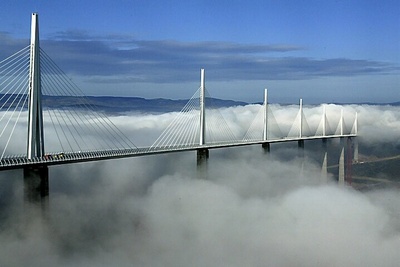
The Millau Viaduct (French : le Viaduc de Millau) is a large cable stayed road bridge that spans the valley of the River Tam near Milalu in southern France. Designed by the architect Lord Norman Foster and his structural engineer Michel Virlogeux, it is the tallest vehicular bridge in the world, with one mast’s summit at 343 mts. (1125 ft) — slightly taller than the Eiffel Tower and only 38 mts (125 ft) shorter than the Empire State Building. The viaduct or bridge is part of the A75-A71 autoroute axis from Paris to Beziersand was inaugrated by the president of France on 14th dec 2004.
Lord Foster (Hong Kong airport and Hearst Tower NY fame) got the commission for the viaduct via an architectural competition which he won in great style. His solution was to design the bridge directly from the cilffs and to design the masts in the shape of a tender butterfly. He intended the structure to be firm and standout in terms of strength but to merge and fade away in the natural beauty of the surroundings.
His design for the bridge was to construct 5 concrete eiffel towers along a gentle arc and to join their top by a bridge, twice high than any other bridge of the world. (Now, the record for highest bridge deck in the world will be soon taken by the Chenab Bridge in the Reasi District of J n K, India, scheduled for completion in December 2009, which will be 359 metres (1,180 ft) high). Only Eiffel Iron Company dared to take the challange (This company had built the Statue of Liberty and the Eiffel Tower itself. In fact Eiffel Tower is named after the owner of this company).
The Millau Bridge consists of an eight-span steel roadway supported by seven concrete pylons. The pylons lie along an arc and taper as they go up. Their exact position was determined via a GPS system and it was ensured many times during the construction process that they were heading towards the correct point in the sky. It was not possible to assemble the roadway at this height due to the risk of high worker casuality.
Frequent storms could break the crane masts resulting in heavy damage to construction and human life. Hence it was to be built on ground and then transported up there. Since concrete would bend and break in these conditions, the roadway is made of steel and not concrete. The bridge required huge amount of steel and concrete, so a concrete factory was set on site and Eiffel iron company transported its iron rebars directly from the furnace to the site. The columns were casted by huge steel moulds.
Due to the tapering shape of the column, these steel plates had to be removed and reangled and then fixed again after every 4 ft. Special care was taken that the concrete was of adequate strength and was of exactly the colour the architect desired.
The roadway could not be lifted up the pylons by cranes, so it was pushed ahead from the edges of the bridge with the help of huge hydraulic pistons. But this method of pushing the roadway ahead is used only in very small span bridges. Here the distance between concrete pylons was twice the safe distance for pushing the roadway up the bridge, so temporary iron spiral columns were created inbetween. Further the deck could hit the piers and tumble them all in a row.
So a heavy weight was first put on the pylons to stablize them, then satelite guided hydraulic systems were mounted on individual pylons and then the roadway was pushed from both the edges of the cliff, which moved at a caterpillar rate of 6cms a day. By this technique, the masts holding the wire cables could not be constructed on the pylons first. So the masts were casted on the roadway itself and they moved with the roadway off the cliff at towards theit resp postitons at the speed of 6 cms a day.
A temporary pillar couldnt be created in the centre of the river, so roadways coming from the two ends had to meet in the centre, which they did with absolute precision, an error fo just 1 cm. Very complex calculations were involved in this since the bridge deck had a gentle slope and was sliightly turning from one end to other. When the temporary pylons were removed, the road deck was found to be in a very loose and loopy state. Steel is tensile, but not this tensile. So each mast was equipped with monoaxial eleven pairs of stays laid face to face.
Depending on their length, the stays were made of 55 to 91 high tensile steel cables or strands. Each strand has triple protection against corrosion (galvanization, a coating of petroleum wax and an extruded polyethylene sheath). These stays tied the bridge and brought it back in shape. This bridge broke the record in terms of the highest and the costliest bridge in the world. Also not even a single casuality happened in this construction, even when the workers were working at the ht of Eiffel Tower. Here are some pics of the megastructure…
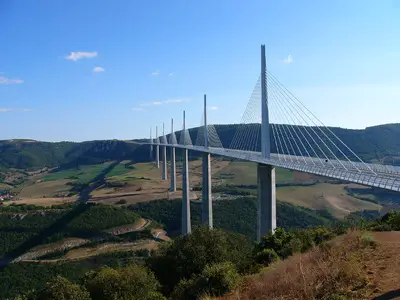
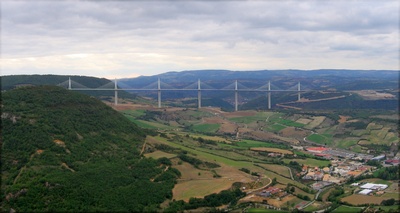
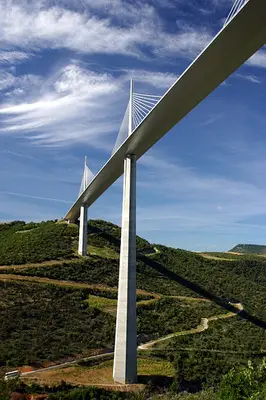
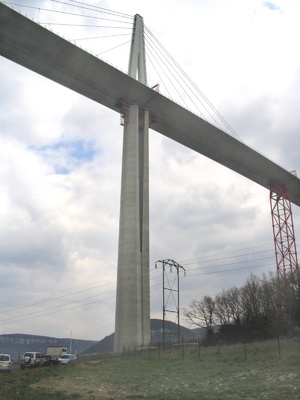
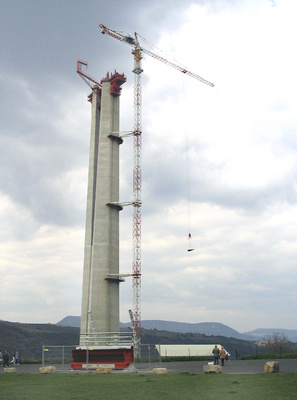
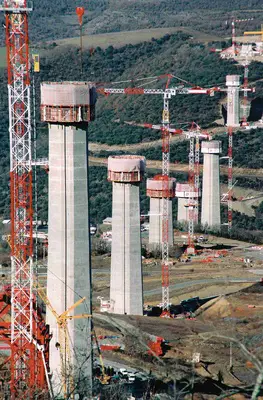
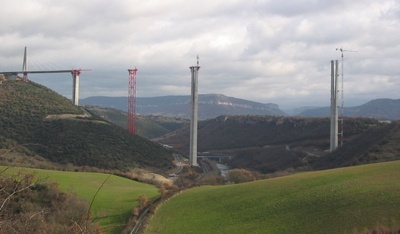

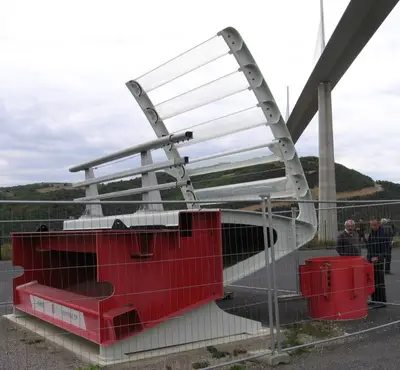
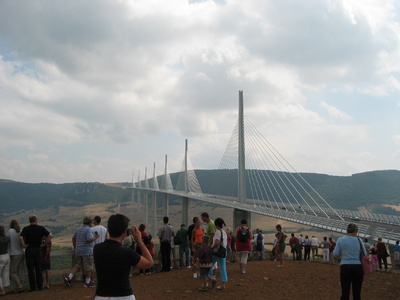
A pic of the architect…
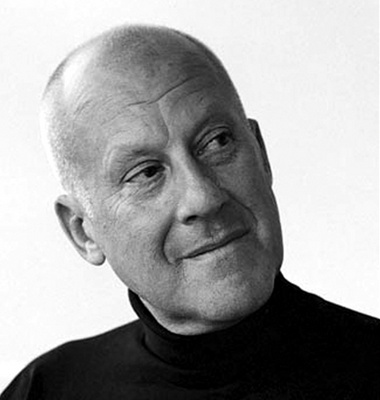
Lord Norman Foster was born in Manchester in 1935. After graduating from
Manchester University School of Architecture and City Planning in 1961
he won a Henry Fellowship to Yale University, where he gained a
Master’s Degree in Architecture.
He is the founder and chairman of Foster + Partners. Founded in London
in 1967, it is now a worldwide practice, with project offices in more
than twenty countries. Over the past four decades the company has been
responsible for a strikingly wide range of work, from urban
masterplans, public infrastructure, airports, civic and cultural
buildings, offices and workplaces to private houses and product design.
Since its inception, the practice has received 470 awards and citations
for excellence and has won more than 86 international and national
competitions.
Current and recent work includes the largest single building on the
planet, Beijing Airport, the redevelopment of Dresden Railway Station,
Millau Viaduct in France, the Swiss Re tower and the Great Court at the
British Museum in London, an entire University Campus for Petronas in
Malaysia, the Hearst Headquarters tower in New York, Boston Museum of
Fine Arts, the Robert and Arlene Kogod Courtyard at the Smithsonian
Institution in Washington and research centres at Stanford University,
California.
He became the 21st Pritzker Architecture Prize Laureate in 1999 and was
awarded the Praemium Imperiale Award for Architecture in 2002. He has
been awarded the American Institute of Architects Gold Medal for
Architecture (1994), the Royal Gold Medal for Architecture (1983), and
the Gold Medal of the French Academy of Architecture (1991). In 1990 he
was granted a Knighthood in the Queen’s Birthday Honours, and in 1999
was honoured with a Life Peerage, becoming Lord Foster of Thames Bank.

This really is an amazing
This really is an amazing megastructure..but the main credit of making such a structure goes to the structural engineering team who did a real tough job of converting this mighty imagination into reality…
Cheers to them…
Yaa…the structural engineer
Yaa…the structural engineer team has really worked their asses up to make this great thing happen…
anyways…great info to share..
The Estrutural team did a
The Estrutural team did a great job! And Sir Foster did an awesome job, he’s great!